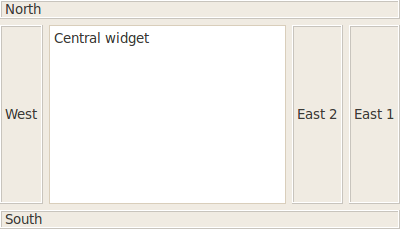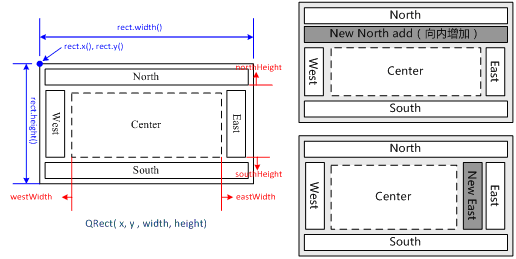
我们进一步学习构建稍微复杂一点的布局。通过对抽象类QLayout的继承来进行自己的布局。在这个例子中,我们将重构QLayout类为BorderLayout,QLayout是一个用于布局管理的基础抽象类,而也是QBoxLayout,QGridLayout,QFormLayout和QStackedLayout的继承类。资料来源:
- http://doc.qt.nokia.com/latest/layouts-borderlayout.html
- http://www.kuqin.com/qtdocument/customlayout.html。
一、搭建project的主题框架
我们创建自己的布局类为BorderLayout,使用borderlayout.cpp和borderlayout.h,构造我们的窗口mywindow.h和mywindow.cpp,以及主程序qtmain.cpp。下面是mywindows.cpp的内容,执行后如图所示。
MyWindow:: MyWindow()
{
QTextBrowser * centralWidget = new QTextBrowser;
centralWidget->setPlainText(tr("Central widget"));BorderLayout * layout = new BorderLayout;
layout -> addWidget (centralWidget,BorderLayout::Center);
layout -> addWidget (createLabel("North"),BorderLayout::North);
layout -> addWidget (createLabel("West"),BorderLayout::West);
layout -> addWidget (createLabel("East 1"),BorderLayout::East);
layout -> addWidget (createLabel("East 2"),BorderLayout::East);
layout -> addWidget (createLabel("South"),BorderLayout::South);
setLayout(layout);
setWindowTitle(tr("Border Layout"));
}QLabel * MyWindow::createLabel(const QString &text)
{
QLabel * label = new QLabel(text);
label->setFrameStyle(QFrame::Box |QFrame::Raised);
return label;
}
二、重点在建立我们的类BorderLayout,我们先建立一个用来存放被布局处理的项目的数据结构QList,每个entry为ItemWrapper,存放组件和位置信息。QLayout的抽象组件为QLayoutItem,实际可以是QLabel等等具体的组件。我们在borderlayout.h中定义:
private:
struct ItemWrapper
{
ItemWrapper(QLayoutItem * i,Position p){
item = i;
position = p;
}
QLayoutItem * item;
Position postion;
};
enum SizeType {MinumumSize, SizeHint};
QSize calculateSize(SizeType sizeType) const; //用于后面
QList list;
三、建立我们自己的布局管理器,需要实现QLayout中的几个virtual的函数。addItem(), sizeHint(), setGeometry(), itemAt() and takeAt(),此外还需要实现minimumSize()用于确保我们的布局没有因为space太小而重置为0。我们去查QLayout的参考(http://doc.qt.nokia.com/latest/qlayout.html),其中pure virtual的有:addItem(),intemAt(),takeAt(),count(),这些都是用于处理item的,分别是增加(存储),查找,删除,总数。我们同时在destory函数中清除所有item。
/********** borderlayout.h PART 2 ***********/
public:
void addItem (QLayoutItem * item);
QLayoutItem * itemAt(int index) const;
QLayoutItem * takeAt(int index);
int count() const;//在我们实际应用中,我们通常不使用addItem,而是使用addWidget,由于我们增加了一个方位因子,所以需要补充一个addWidget的方法。
void addWidget(QWidget * w, Position p);/********** borderlayout.cpp PART 2 ***********/
BorderLayout::~BorderLayout()
{
QLayoutItem *l;
while((l = takeAt(0)) != NULL)
delete l;
}//在我们存储的数据中加入元素,addItem在实际上是很少调用的,一般都会使用addWidget,它将使用addItem。
void BorderLayout :: addItem(QLayoutItem * item)
{
list.append(new ItemWrapper(item,West));
}//takeAt表示从list中删除index的item,并返回它,而index必须是有效的数值,因此需要先行检查:0 <= i < size()).
QLayoutItem * BorderLayout :: takeAt(int index)
{
if(index >= 0 && index < list.size()){
ItemWrapper * layoutStruct = list.takeAt(index);
return layoutStruct -> item;
}
return 0;
}QLayoutItem * BorderLayout :: itemAt(int index) const
{
ItemWrapper * wrapper = list.value(index);
if(wrapper)
return wrapper->item;
else
return 0;
}int BorderLayout::count() const
{
return list.size();
}void BorderLayout :: addWidget(QWidget * item, Position position)
{
list.append(new ItemWrapper(new QWidgetItem (item),position));
}
四、编译:undefined reference to `BorderLayout::sizeHint() const QLayoutItem是QLayout操作的一个抽闲的item,有一些方法从QLayoutItem中继承,例如sizeHint表示implemented in subclasses to return the preferred size of this item,那么对于layout则表示整个layout的大小。而在QLayout中说明: sizeHint(), 此外通常还需要实现minimumSize(),我们一起补上,此外,我们还加上了expandingDirections(用于表明这个layout可以使用比sizeHint()更多的空间,并允许向那个维度扩展)
/************* borderlayout.cpp PART 3 ***************/
Qt::Orientations BorderLayout::expandingDirections() const
{
return Qt::Vertical | Qt::Horizontal; //两个方向均允许扩展。
}QSize BorderLayout :: sizeHint() const
{
return calculateSize(MinimumSize);
}QSize BorderLayout :: minimumSize() const
{
return calculateSize(SizeHint);
}//将各item的大小进行统计获得layout的大小
QSize BorderLayout::calculateSize(SizeType sizeType) const
{
QSize totalSize;for(int i = 0 ; i < list.size(); i++){
ItemWrapper * wrapper = list.at(i);
Position position = wrapper -> position;
QSize itemSize;if(sizeType == MinimumSize)
itemSize = wrapper->item->minimumSize();
else // SizeHint
itemSize = wrapper->item->sizeHint();if(position == North || position == South || position == Center)
totalSize.rheight() += itemSize.height();if(position == West || position == East || position == Center)
totalSize.rwidth() += itemSize.width();
}
return totalSize;
}
五、setGeometry()是最重要的一个,用于描述这个布局,我们重造该方法:
void BorderLayout::setGeometry(const QRect &rect)
{
QLayout::setGeometry(rect);
/* Add you code here*/
}
在这里,我们向描述一下我们Layout的情况。

在这个图的基础上我们来布局。我们从QList中读出我们的组件,根据组件的位置属性,我们先完成南北向的组件布局,在完成东西向的组件布局,布局使用QRect来确定每个组件的大小,每个组件都有一个缺省的大小item->sizeHint().width()和item->sizeHint().height(),对于南北,宽度等同于整个layout,而东西,高度修正为同center的大小。明确了正阳的布局,我们编写下面的代码:
void BorderLayout::setGeometry(const QRect &rect)
{
ItemWrapper * center = NULL;
int eastWidth = 0,westWidth = 0,northHeight = 0 ,southHeight = 0, centerHeight = 0;for(int i = 0; i < list.size(); i ++){
ItemWrapper * wrapper = list.at(i);
QLayoutItem * item = wrapper -> item;
Position position = wrapper->position;
if(position == North){
item->setGeometry(QRect(rect.x(),northHeight, rect.width(),item->sizeHint().height()));
northHeight += item->sizeHint().height() +spacing();
}else if(position == South){
item->setGeometry(QRect(rect.x(), rect.height()-southHeight-item->sizeHint().height(),rect.width(), item->sizeHint().height()));
southHeight += item->sizeHint().height() + spacing();
}else if(position == Center){
center = wrapper;
}
}centerHeight = rect.height()- northHeight-southHeight;
for(int i = 0; i < list.size(); i ++){
ItemWrapper * wrapper = list.at(i);
QLayoutItem * item = wrapper -> item;
Position position = wrapper->position;
if(position == West){
item->setGeometry(QRect(rect.x() + westWidth,northHeight,item->sizeHint().width(),centerHeight));
westWidth += item->sizeHint().width()+spacing();
}else if(position == East){
item->setGeometry(QRect(rect.width()-eastWidth-item->sizeHint().width(),northHeight,
item->sizeHint().width(),centerHeight));
eastWidth += item->sizeHint().width() + spacing();
}
}
if(center)
center->item->setGeometry(QRect(westWidth,northHeight, rect.width()-eastWidth-westWidth,centerHeight));
}
相关链接:我的MeeGo/Moblin相关文章
此外,看到这么一则小故事也copy下来:倒墙的前两年,东德一个名叫亨里奇的守墙卫兵,开枪射杀了攀爬柏林墙企图逃向西德的青年克利斯。1992年2月,在统一后的柏林法庭上,卫兵亨里奇受到审判。他的律师辩称,他们仅仅是执行命令的人,根本没有选择的权利,罪不在己。那么法官是怎么说怎么判的呢?法官当庭指出:“作为警察,不执行上级命令是有罪的,但是打不准是无罪的。作为一个心智健全的人,此时此刻,你有把枪口抬高一厘米的主权,这是你应主动承担的良心义务。这个世界,在法律之外还有‘良知’。当法律和良知冲突之时,良知是最高的行为准则,而不是法律。尊重生命,是一个放之四海而皆准的原则。”你有把枪口抬高一厘米的主权――在那个万不得已的情势下,打,但应该有意打不准 ――不把人家打死,这是最低限度的道德,这也是最高境界的良知。任何人都不能以“服从命令”为借口,去超越道德伦理的底线。 这就是“一厘米主权”的道德义务,否则就必须承担罪责。柏林法庭最终的判决是:判处开枪射杀克利斯的卫兵亨里奇三年半徒刑,不予假释。



























 880
880

 被折叠的 条评论
为什么被折叠?
被折叠的 条评论
为什么被折叠?








